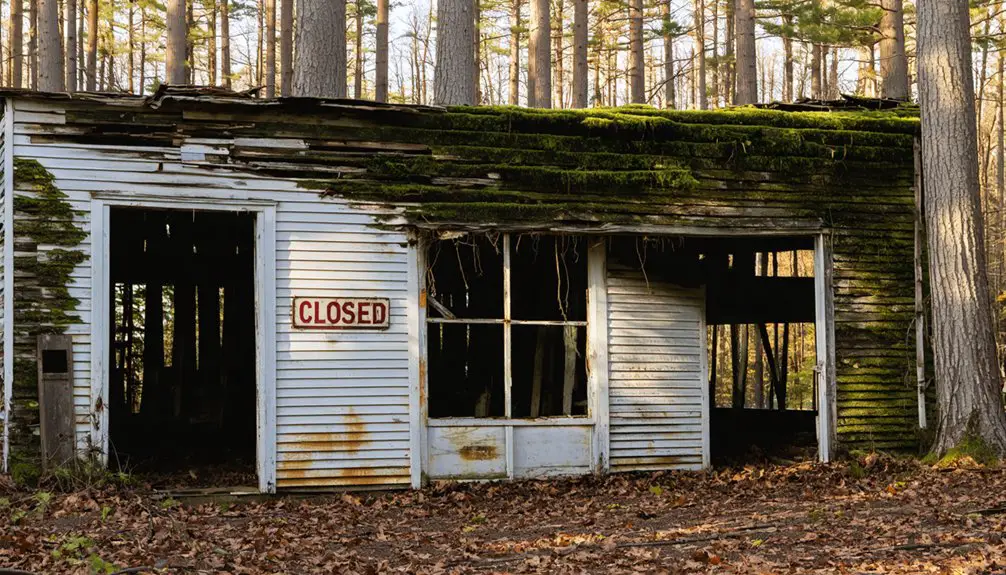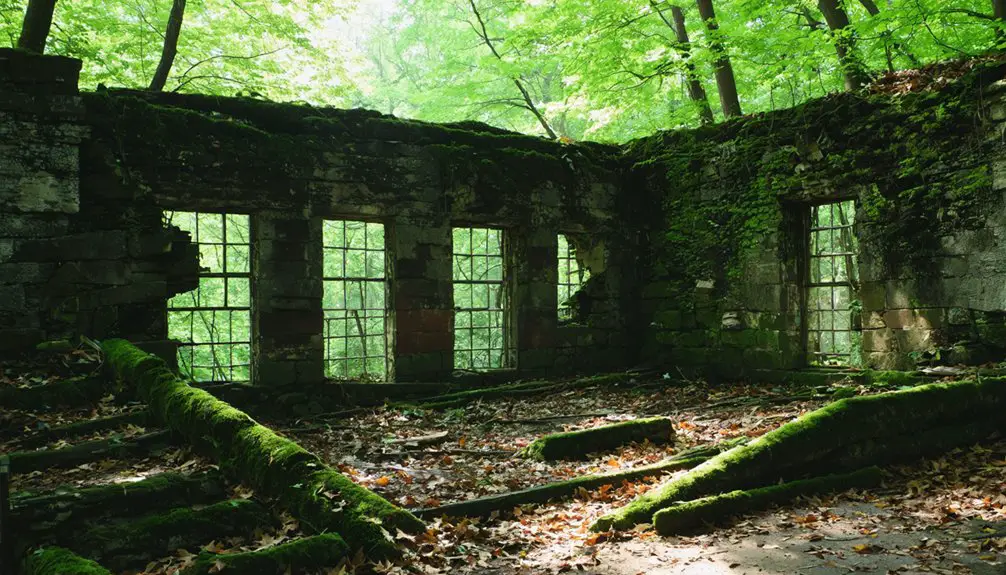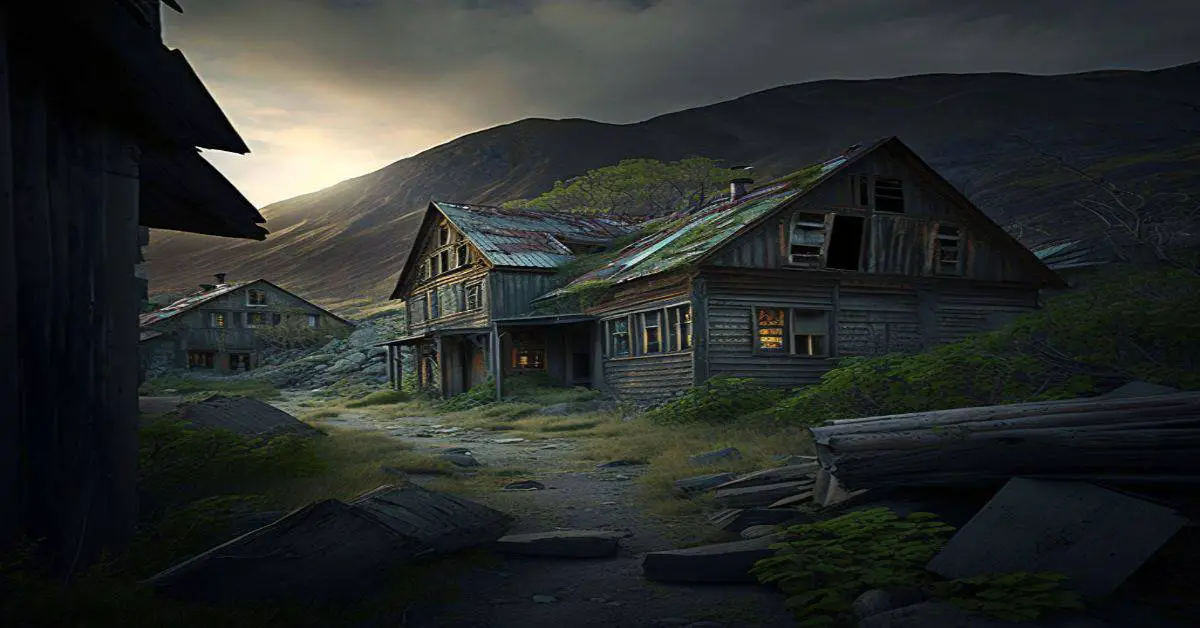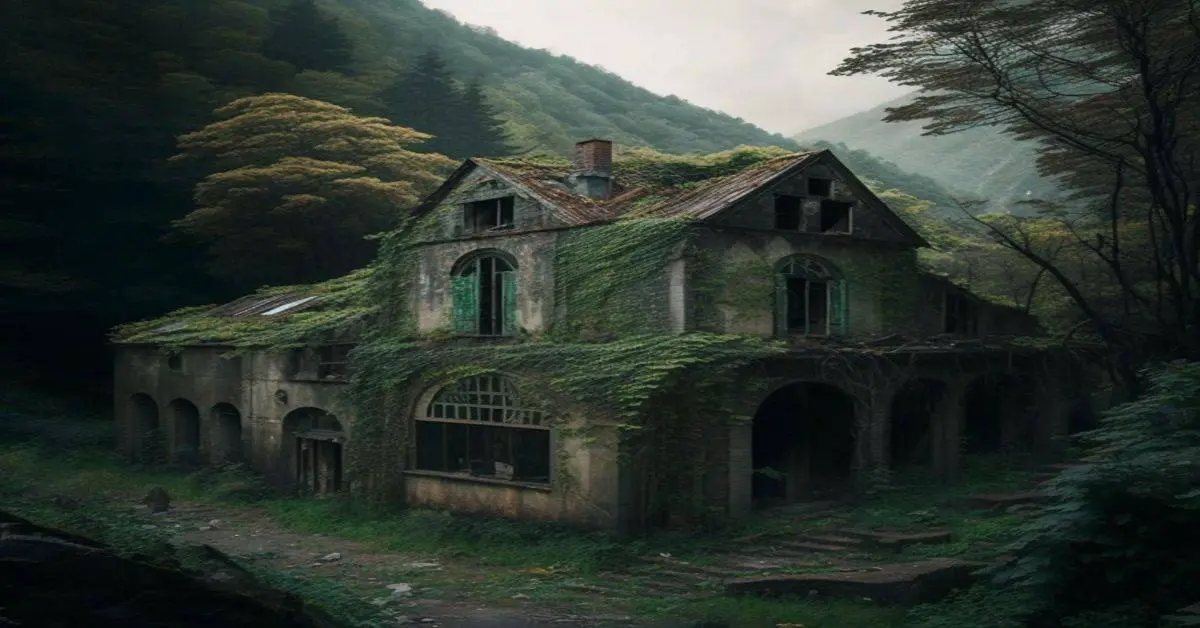You’ll find Deward’s haunting ruins between Gaylord and Grayling in Crawford County, Michigan, where David E. Ward’s lumber empire once thrived. From 1901-1912, this company town supported 200 families while its modern sawmill processed an impressive 52 million board feet annually. The town’s concrete foundations now lie hidden beneath dense forest canopy, accessible via County Road 612 and Manistee River Road. The site’s scattered artifacts and industrial remnants tell a fascinating story of Michigan’s logging heyday.
Key Takeaways
- Deward was a lumber company town that thrived from 1901-1912, built around a massive sawmill processing Michigan’s white pine forests.
- The town supported 800 residents at its peak, with 200 families living in company-controlled housing and working at the mill.
- The White Pine Mill operated continuously with two 12-hour shifts, producing 52 million board-feet of lumber annually.
- The town declined rapidly after 1912 when surrounding timber resources were depleted, leading to complete abandonment.
- Today, only concrete foundations remain among regrown forest, accessible via County Road 612 and Manistee River Road.
The Birth of a Lumber Empire
Industrial ambition shaped the birth of Deward, Michigan when lumber baron David E. Ward established his timber empire in northern Michigan’s wilderness.
You’ll find that Ward’s vision centered on exploiting the last remaining virgin pine forests, where towering white pines reached heights of nearly 200 feet, each yielding an impressive 7,856 board-feet of lumber.
Ward’s lumber legacy began with the purchase of vast tracts of old-growth pine, leading to the construction of a modern sawmill in 1901. By 1912, Deward’s once thriving community saw its population decline as the surrounding trees were depleted.
D.E. Ward’s visionary purchase of pristine pine forests laid the foundation for a modern sawmill, transforming Michigan’s timber industry.
The economic impact was significant – the mill could process 52 million board-feet annually.
The town, named as a contraction of “D.E. Ward,” became a strategic hub with its standard-gauge railroad connecting to East Jordan’s shipping port, maximizing efficiency in lumber transportation and processing.
After Ward’s death in 1900, his heirs were required to complete the 12-year liquidation of the entire timber estate.
Life in a Company Town
While lumber production drove Deward’s economy, daily life revolved around a carefully structured company town designed to support around 200 families.
You’d find two neat rows of company housing, from boarding houses to single-family homes, all under strict Ward estate control. The town’s social dynamics centered on key gathering spots like the community hall, where you could join dances and events that brought the town’s 800 residents together.
Though you couldn’t buy liquor in town due to company restrictions, nearby Frederic offered that freedom. You’d do your shopping at the company store, send your kids to the town school, and perhaps attend the Swedish Lutheran Church. The town thrived until white pine supplies exhausted by 1912. Today, only concrete foundations remain as silent reminders of this once-bustling town.
Despite the heavy company control, residents forged a close-knit community within these regulated confines.
The Mighty White Pine Mill
You’ll be impressed by the sheer scale of Deward’s White Pine Mill, which processed trees up to 200 feet tall and could cut 200,000 board feet every 20 hours.
The mill’s advanced clutch system kept production flowing around the clock, with crews working two 12-hour shifts six days a week to fill approximately 15 boxcars daily. Transported via the Detroit and Charlevoix Railroad, lumber reached major markets in Chicago, Detroit, and Cleveland.
Operating at peak efficiency, the mill supplied lumber across America and even to Argentina, making it one of Michigan’s most productive facilities during the early 1900s. The mill was nestled in an expansive forest of red and white pines that provided abundant raw materials.
Mill’s Record Production Numbers
The Mighty White Pine Mill of Deward achieved remarkable production numbers during its decade of continuous operation, reaching peak cutting capacity of 52 million board-feet annually.
You’ll be amazed to know this output surpassed half of what Perry Hannah’s mill produced in Traverse City over 15 years.
Operating around the clock, the mill processed massive white pines, including a record-breaking tree nearly 200 feet tall that yielded 7,856 board-feet of lumber.
The mill’s production wasn’t just impressive in volume – it reached far and wide. You could track lumber exports from Deward to Chicago via rail and barge, and even to Argentina during its construction boom.
The mill’s efficient operation continued until it had harvested all 90,000 acres of surrounding timberland.
This impressive production scale rivaled that of Michigan’s White Pine Mine, which produced an astounding 4 billion pounds of copper during its operation.
Lumber Operations and Equipment
Standing proof to late 19th-century industrial ingenuity, Deward’s mighty sawmill operated as a marvel of mechanical efficiency. The two-story wooden structure showcased cutting-edge lumber technology, with a steam-powered engine driving both the inclined log ramp and saw operations. Like many operations of that era, the mill relied on cross-cut saws for initial timber felling.
You’d find logs being lifted from Otter Creek’s mill pond via a chain loop system, then transported to the second floor where the main sawing took place.
The mill’s equipment evolution included an innovative clutch system that kept operations running during repairs, while a network of belts and pulleys transferred power throughout the facility. At its peak production, the mill produced 52 million board feet annually.
From the sawing floor, freshly cut lumber moved along an elevated tramway to the dock for shipping. The scale of operations was impressive – their largest single tree yielded 7,856 board-feet of lumber.
Daily Operations and Peak Years
During its peak years from 1901 to 1912, Deward’s massive sawmill churned out an impressive 200,000 board feet of lumber daily while employing hundreds of workers in a precisely orchestrated operation.
You’d find the daily routines centered around the constant flow of pine logs arriving by narrow gauge rail, where worker camaraderie developed amid the demanding physical labor.
The town bustled with nearly 800 residents during these peak years, with most families’ livelihoods tied directly to the mill.
With 800 souls calling it home, this bustling mill town’s prosperity flowed from the sawdust-filled air to every family’s table.
You could witness the purposeful rush to clear-cut and process the surrounding pine forests, all according to David E. Ward’s will that specified completing the harvest within about a decade.
The intense pace of operations reflected the company town’s singular focus on maximum timber extraction. The mill’s closure in 1912 marked the beginning of the town’s eventual abandonment.
The Mandated Shutdown

In accordance with David E. Ward’s will, the lumber mill was forced to cease operations after just 10 years, around 1912. This unique mandate, likely intended to limit timber cutting, triggered devastating shutdown consequences for the once-thriving town of 800 residents.
You’d have witnessed the rapid decline as hundreds of workers lost their jobs at the mill and related trades. Despite attempts at community resilience, the town’s economic foundation crumbled as supporting businesses closed their doors. Families were forced to abandon their homes and relocate, while schools, churches, and community centers gradually emptied.
The mill’s closure wasn’t just about jobs – it marked the end of Deward’s liveliness. By 1932, this former lumber boomtown had transformed into one of Michigan’s ghost towns, its buildings dismantled and its streets silent.
Nature Reclaims the Land
Today’s dense forest canopy in Deward reveals little of its industrial past, as nature steadily reclaimed the abandoned town after 1932. Where towering 45-meter pines once stood before clear-cutting, you’ll now find a diverse mix of young hardwoods and pines through natural forest succession.
Nature’s resilient hand transforms industrial ruins into fresh forest, erasing traces of human enterprise beneath new growth.
You can still spot scattered remnants beneath the vegetation – concrete foundations from the sawmill and houses, along with occasional bits of broken glass and debris.
But the land’s transformation is striking. Wildlife habitat has flourished as native plants recolonized the area, providing shelter for birds and mammals. The soil, once disrupted by logging and construction, has begun healing through decades of natural processes.
Even where oil pumps now stand, the surrounding forest continues its relentless reclamation of this former boomtown.
Exploring the Ghost Town Today
If you’re planning to explore Deward’s remains today, you’ll need to navigate a network of winding dirt roads west of I-75 and be prepared for multiple attempts to find the exact location among the dense forest.
While GPS can guide you to the general area, locating the concrete foundations and sawmill ruins requires careful searching through open fields and wooded terrain, as nature has largely reclaimed the former townsite.
Your persistence will be rewarded with discoveries of scattered artifacts, broken glass, and the substantial concrete foundations that mark where one of Michigan’s largest sawmills once operated until 1912.
Finding the Town Ruins
Located halfway between Gaylord and Grayling in Crawford County, Michigan, the ruins of Deward await determined explorers willing to venture down dirt roads and forest paths.
You’ll find the site by taking County Road 612, then heading north on Manistee River Road past West Cameron Bridge Road. The ruins lie about a quarter mile south of where Manistee River Road meets Post Road.
Don’t expect standing buildings – instead, you’ll discover scattered concrete foundations from the old lumber mill and houses, now partially hidden by decades of forest regrowth.
While modern oil pumps dot the landscape, the historical significance of this former lumber baron’s town remains.
For the best exploration, bring GPS and detailed local maps, as the ruins can be challenging to locate among the dense forest and uneven terrain.
Reaching Deward’s ghost town ruins requires careful navigation through a network of challenging forest roads that wind through Michigan’s dense northern woodlands.
You’ll need a high-clearance 4WD or AWD vehicle equipped with recovery gear to tackle the dirt roads’ uneven surfaces, sand pits, and mud hazards.
Plan your route using detailed maps and GPS, as you’ll encounter limited signage and spotty cell service while traversing the Black Forest and Wilderness Valley region.
Start from Gaylord or Grayling, heading west off I-75.
Pack extra supplies, including fuel, food, water, and emergency equipment – there aren’t any services nearby.
Check weather conditions and seasonal road closures before setting out, as winter snow and spring thaw can make these remote forest roads impassable.
Remnants Worth Discovering
Today’s visitors to Deward will find an array of concrete foundations and scattered remnants that paint a picture of this once-thriving lumber town. As you explore the ghost town‘s footprint, you’ll discover dozens of building foundations, including the impressive remains of the central sawmill that once powered Deward’s economy until 1912.
For artifact preservation enthusiasts, the site offers fascinating finds in former garbage pits, where century-old glass bottles, zinc Mason jar lids, and iron machinery parts tell stories of daily life.
While searching with metal detectors, you’ll need to navigate through the dense regrown forest that now surrounds these historical markers. The foundations, spread across the wilderness about a quarter mile south of Manistee River Road and Post Road, reveal how this bustling community of 800 residents once organized their lives around the lumber industry.
Hidden Treasures and Archaeological Findings
While Deward’s buildings have long since vanished, the ghost town’s hidden treasures remain scattered throughout Michigan’s Black Forest, waiting to be discovered by those who venture off the beaten path.
You’ll find concrete foundations of the once-mighty sawmill nestled beneath regrown forest, offering glimpses into the town’s industrial past. Through artifact analysis, scattered remnants tell stories of daily life during Deward’s lumber boom – broken glass and industrial debris provide valuable historical context about the community that thrived here from 1900 to 1912.
The mill’s foundations reveal the impressive scale of operations that processed towering 45-meter pines until the forests were depleted. Today, these archaeological traces lie partially hidden under new growth, preserving clues to Michigan’s lumber heritage.
Frequently Asked Questions
Were There Any Notable Accidents or Deaths During Deward’s Operational Years?
Truth is stranger than fiction – but you won’t find any documented accident reports or deaths from Deward’s lumber operations. Despite logging’s dangers, historical records don’t reveal any specific worker safety incidents.
What Happened to the Families and Workers After the Town Closed?
You’ll find that families dispersed widely after the mill’s closure, with most migrating to nearby towns like Gaylord and Grayling. The economic impact forced workers to seek opportunities elsewhere.
Did Any Original Structures Survive the Great Depression Fire?
When push came to shove, you won’t find any original architecture that survived the Great Depression fire. Historical preservation wasn’t possible as flames completely consumed what remained of the town’s structures.
Were There Schools or Churches Established During Deward’s Brief Existence?
You won’t find records of formal school attendance or church activities during this period, as historical evidence suggests the lumber town lacked permanent educational or religious buildings amid its short-lived existence.
What Was the Average Wage for Mill Workers in Deward?
You’d find mill workers earned between $30-$50 monthly, with wage comparisons showing skilled workers making up to $2 per day, while enduring tough worker conditions during 12-hour shifts.
References
- https://99wfmk.com/deward-michigan-ghost-town2/
- https://lostinmichigan.net/the-lost-and-found-michigan-ghost-town-of-deward/
- https://forths.com/index.php/2022/05/29/ghost-town-of-deward-michigan/
- https://www.nailhed.com/2016/09/pines-last-stand.html
- https://lostinmichigan.net/the-ghost-town-of-deward/
- https://www.rae.org/lewiston/
- http://www.michigan-history.org/lumbering/LumberingBriefHistory.html
- https://www.betweenthepines.org/post/deward-reminder-of-the-lumbering-era
- https://random-times.com/2022/06/15/deward-the-ghost-town-still-on-the-maps-that-completely-vanished/
- https://99wfmk.com/dewardghosttown/


